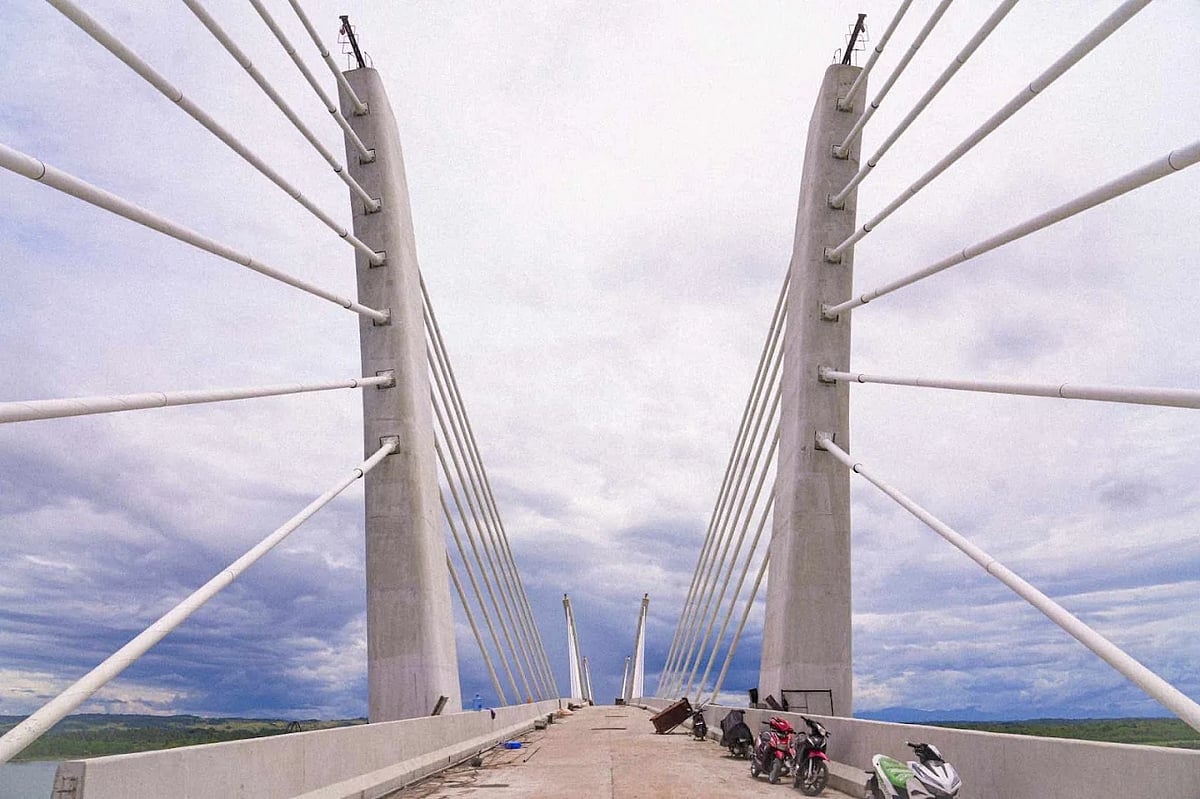Camalaniugan Bridge to Open by Christmas 2025
The Camalaniugan Bridge, a remarkable feat of engineering in the northern Philippines, is nearing completion and is expected to significantly enhance local infrastructure. Spanning 1,580 meters, this cable-stayed bridge connects the towns of Aparri and Camalaniugan, approximately 580 kilometers north of Manila. With its striking design and functional capabilities, the bridge has garnered national attention and pride.
Engineering Excellence and Local Pride
During a recent inspection, President Ferdinand Marcos Jr. praised the bridge as a symbol of Filipino ingenuity. He emphasized that while the design draws inspiration from international standards, it is a product of local talent. “We are looking at one of the most beautiful bridges that we have created in the Philippines,” he stated, highlighting the importance of homegrown engineering in achieving world-class infrastructure.
The bridge is not only aesthetically pleasing but also incorporates an integrated flood control system, showcasing a commitment to sustainable and resilient infrastructure. President Marcos noted, “It reflects what proper infrastructure should look like,” commending the efforts of local officials, including Cagayan Governor Edgar Aglipay, who have worked diligently to ensure the project’s success.
Project Overview and Timeline
The ₱4-billion (approximately $72 million) project is a collaboration between Agafer Construction and China’s Hunan Road and Bridge Construction, executed under a design-and-build scheme. Construction began in 2021, but progress faced setbacks due to the COVID-19 pandemic. Currently, an additional ₱260.2 million is needed to complete the remaining phases, with full project completion anticipated by January 2026.
Despite these challenges, President Marcos expressed optimism that the bridge could open to the public as early as Christmas 2025. Once operational, it will provide a vital alternative route to the aging Magapit Suspension Bridge, significantly reducing travel time between Aparri and Ballesteros from one hour to just 20 minutes. This improvement is expected to benefit over 6,000 daily commuters.
Key Milestones
– **2021**: Construction commenced under a joint venture between Agafer Construction and Hunan Road and Bridge Construction. – **2021-2023**: Progress was delayed due to the impact of the COVID-19 pandemic. – **Late 2025**: Expected nearing of physical completion. – **Christmas 2025**: Potential early opening to the public. – **January 2026**: Targeted full project completion with all remaining works finalized.
FAQs
What is the significance of the Camalaniugan Bridge?
The bridge is significant as it represents a major advancement in local infrastructure, enhancing connectivity and reducing travel time for thousands of commuters.
When is the expected completion date for the bridge?
While full completion is targeted for January 2026, there is optimism for an early opening to the public by Christmas 2025.
Who are the main contractors for the bridge project?
The project is a collaboration between Agafer Construction, a local firm, and Hunan Road and Bridge Construction, a company based in China.
Conclusion
The Camalaniugan Bridge is set to be a transformative infrastructure project for the northern Philippines, showcasing local engineering capabilities and enhancing regional connectivity. With an anticipated early opening by Christmas 2025, this bridge will not only improve travel times but also stand as a testament to Filipino ingenuity and resilience in infrastructure development.
The Camalaniugan Bridge is part of a broader initiative by the Philippine government to improve transportation networks across the archipelago. This project aligns with the “Build, Build, Build” program, which aims to upgrade infrastructure to stimulate economic growth and enhance mobility. By connecting key regions, the bridge is expected to facilitate trade and tourism, contributing to the overall development of the Cagayan Valley region.
In addition to its practical benefits, the bridge is designed to withstand natural disasters, a crucial consideration in a country frequently affected by typhoons and flooding. The integrated flood control system aims to mitigate the impact of heavy rainfall, ensuring that the bridge remains operational during adverse weather conditions. This focus on resilience reflects a growing recognition of the need for infrastructure that can endure the challenges posed by climate change.
As the project progresses, local communities are hopeful about the economic opportunities that the bridge will bring. Improved access to markets and services is anticipated to foster local businesses and create jobs, thereby enhancing the quality of life for residents in the surrounding areas. The Camalaniugan Bridge stands as a symbol of progress, embodying the aspirations of many Filipinos for a more connected and prosperous future.
Also Read:
Mubadala Abu Dhabi Open Returns in January 2026






